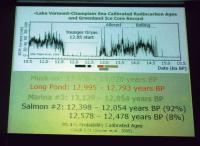
Serving the Vermont Champlain Valley Area for 45 Years
Main SectionsFront Page SportsValley VitalsIt's in the StarsStarwiseArchivesLinksAbout The VoiceContact Us |
Middlebury Professor Points To Possibility Of Glacial Melting Damage Plus Ice Age Conditions
Tuesday February 26, 2008 By Ed Barna Someone from the Yukon who posts pictures on an outdoor photo-sharing website recently showed how grim dawn looks at minus 61 degrees F. He was at 63 degrees latitude, he said--the Arctic Circle being between 66 and 67 degrees latitude. The next day in Trondheim, Norway--also at 63 degrees latitude--the temperature was plus 34 F, said Accuweather. In Middlebury, latitude almost exactly 44, an outdoor thermometer at the time read plus 12 F. Why? “The Gulf Stream,” you may be thinking, if you studied ocean currents in school-that is, the 15-mile wide flow of Caribbean water that moves up through the Atlantic Ocean toward Europe. Right, would say the Addison County resident who used to run a website about Ireland, who said that in Cork County the Gulf Stream makes it possible to grow palm trees. “But,” says Little Johnny from the back of the classroom, “where does the Gulf Stream go after that?” To simplify a bit, as that water grows colder, it joins other cold water from the Arctic regions of the North Atlantic to form a cold current that flows far down below the Gulf Stream (cold water sinks, warm water rises) but in the opposite direction. It's an arrangement that Middlebury College professor Patricia Manley called “the conveyor belt” in a lecture titled "Glacial Lake Discharges and Abrupt Climate Change: Lake Champlain." “But,” says Little Jeannie, “could that warm-and-cold-water system ever shut down?” “Good question,” says Dr. Manley (paraphrasing here). “It already has, twice, and thanks to global warming, it could do so a third time, and very quickly once it started to happen.” Climate theory contrarians say that the “greenhouse effect” from carbon dioxide is very small, compared with the effect of fluctuations in the amount of sunlight, and their information suggests we may actually be headed for another ice age. (The great majority of climate scientists say the solar influence theory has been carefully examined and thoroughly discredited, and unless major steps are taken as soon as possible to reverse the human-induced increase in atmospheric greenhouse gases, coastal flooding and other effects will create unprecedented environmental and economic devastation.) To her audience of mainly students and faculty members, Manley offered a third, worst-of-both-worlds scenario: the same deluge of water melted from the Greenland and Antarctic ice sheets could create both coastal catastrophes AND an ice age. “We could have both,” she said. As the last Ice Age ended, the water from melting glaciers at first went down the center of the North American continent to the Gulf of Mexico, she said. But then the flow shifted to the North Atlantic, particularly when a geological dam holding back ancient Lake Agassiz (in the middle of Canada) gave way, releasing massive amounts of fresh water. Fresh water does not immediately mix with salt water, Manley said. Being lighter, it can form a cap on the salt water-and did so during the Younger Dryas period. Named for the arctic flower Dryas octopetalas, this extremely cold spell lasted from about 14,000 to 11,000 years ago, she said. There being no written records from that time, scientists use geological evidence for the dates, such as whether the remains of saltwater or freshwater microlife predominate a level of a soil core sample, or whether there is more of the form of oxygen (isotope 18) that is more characteristic of fresh water. Manley's presentation was cautious, judicious, and thoroughly scientific, but did raise concerns about what might happen if Greenland and Antarctic glaciers melted quickly. In discussions afterward, she drew support from her husband and fellow professor, oceanographer Tom Manley. Fresh water is “absolutely a key” to what could happen, he said. Yes, he agreed, the “conveyor belt” could shut down.
|
AdvertisementsSearch our Archives |
Agricultural Weather Forecast:

© 2006-18 The Valley Voice • 656 Exchange St., Middlebury, VT 05753 • 802-388-6366 • 802-388-6368 (fax)
Valleywides: [email protected] • Classifieds: [email protected] • Info: [email protected]

 Printer Friendly
Printer Friendly